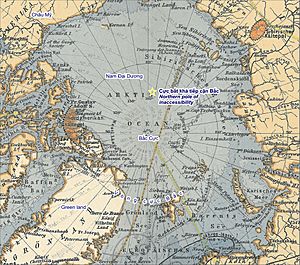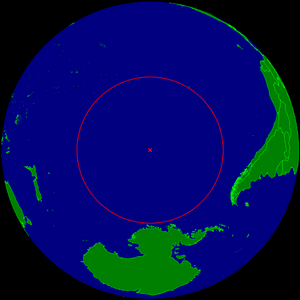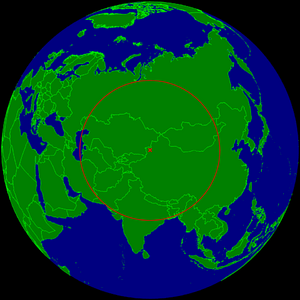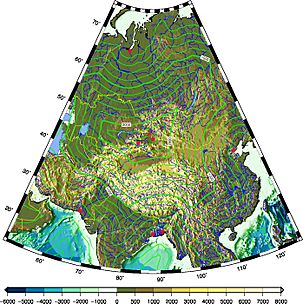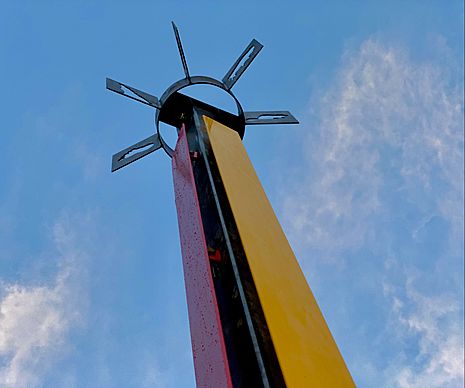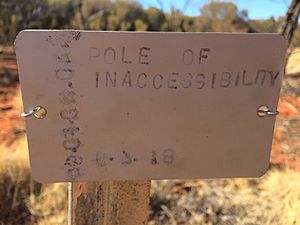Pole of inaccessibility facts for kids
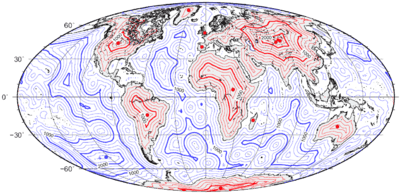
A pole of inaccessibility with respect to a geographical criterion of inaccessibility marks a location that is the most challenging to reach according to that criterion. Often it refers to the most distant point from the coastline, implying a maximum degree of continentality or oceanity. In these cases, pole of inaccessibility can be defined as the center of the largest circle that can be drawn within an area of interest without encountering a coast. Where a coast is imprecisely defined, the pole will be similarly imprecise.
Contents
Northern pole of inaccessibility
The Northern pole of inaccessibility, sometimes known as the Arctic pole, is located on the Arctic Ocean pack ice at a distance farthest from any land mass.
The original position was falsely believed to lie at 84°03′N 174°51′W. It is not clear who first defined this point but it may have been Sir Hubert Wilkins, who wished to traverse the Arctic Ocean by aircraft, in 1927. He was finally successful in 1928.
In 1968 Sir Wally Herbert came very close to reaching what was then considered to be the position by dogsled but by his own account, "Across The Roof Of The World", did not make it due to the flow of sea ice.
In 1986, an expedition of Soviet polar scientists led by Dmitry Shparo claimed to reach the original position by foot during a polar night.[citation needed]
In 2005, explorer Jim McNeill asked scientists from National Snow and Ice Data Center and Scott Polar Research Institute to re-establish the position using modern GPS and satellite technology. This was published as a paper in the Polar Record, Cambridge University Press in 2013.
McNeill launched his own, unsuccessful, attempt to reach the new position in 2006, whilst measuring the depth of sea-ice for NASA.
In 2010 he and his Ice Warrior team was thwarted again by the poor condition of the sea ice.
The new position lies at 85°48′N 176°9′W, 1,008 km (626 mi) from the three closest landmasses: It is 1008 km from the nearest land, on Henrietta Island in the De Long Islands, at Arctic Cape on Severnaya Zemlya, and on Ellesmere Island. It is over 200 km from the originally accepted position. Due to constant motion of the pack ice, no permanent structure can exist at this pole.
As of February 2021, McNeill said that, as far as he could ascertain, no one had reached the new position of the Northern Pole of Inaccessibility - certainly not from the last landfall across the surface of the ocean and it remains an important scientific transect.
Southern pole of inaccessibility
The southern pole of inaccessibility is the point on the Antarctic continent most distant from the Southern Ocean. A variety of coordinate locations have been given for this pole. The discrepancies are due to the question of whether the "coast" is measured to the grounding line or to the edges of ice shelves, the difficulty of determining the location of the "solid" coastline, the movement of ice sheets and improvements in the accuracy of survey data over the years, as well as possible topographical errors.
The pole of inaccessibility commonly refers to the site of the Soviet Union research station mentioned below, which was constructed at 82°06′S 54°58′E / 82.100°S 54.967°E (though some sources give 83°06′S 54°58′E / 83.100°S 54.967°E). This lies 878 km (546 mi) from the South Pole, at an elevation of 3,718 m (12,198 ft). Using different criteria, the Scott Polar Research Institute locates this pole at 85°50′S 65°47′E / 85.833°S 65.783°E.
According to ThePoles.com, the point farthest from the sea accounting only for the Antarctic land surface proper is at 82°53′14″S 55°4′30″E / 82.88722°S 55.07500°E, and the farthest point when ice sheets are taken into account is 83°50′37″S 65°43′30″E / 83.84361°S 65.72500°E. These points, calculated by the British Antarctic Survey, are quoted as being "the most accurate measure available" (as of 2005).
The southern pole of inaccessibility is far more remote and difficult to reach than the geographic South Pole. On 14 December 1958, the 3rd Soviet Antarctic Expedition for International Geophysical Year research work, led by Yevgeny Tolstikov, established the temporary Pole of Inaccessibility Station (Polyus Nedostupnosti) at 82°06′S 54°58′E / 82.100°S 54.967°E. A second Russian team returned there in 1967. Today, a building still remains at this location, marked by a bust of Vladimir Lenin that faces towards Moscow, and protected as a historical site.
On 4 December, 2006, Team N2i, consisting of Henry Cookson, Rupert Longsdon, Rory Sweet and Paul Landry, embarked on an expedition to be the first to reach the historic pole of inaccessibility location without direct mechanical assistance, using a combination of traditional man hauling and kite skiing. The team reached the old abandoned station on 19 January, 2007, rediscovering the forgotten statue of Lenin left there by the Soviets some 48 years previously. The team found that only the bust on top of the building remained visible; the rest was buried under the snow. The explorers were picked up from the spot by a plane from Vostok base, flown to Progress Base and taken back to Cape Town on the Akademik Fyodorov, a Russian polar research vessel.
On 11 December, 2005, at 7:57 UTC, Ramón Hernando de Larramendi, Juan Manuel Viu, and Ignacio Oficialdegui, members of the Spanish Transantarctic Expedition, reached for the first time in history the southern pole of inaccessibility at 82°53′14″S 55°04′30″E / 82.88722°S 55.07500°E, updated that year by the British Antarctic Survey. The team continued their journey towards the second southern pole of inaccessibility, the one that accounts for the ice shelves as well as the continental land, and they were the first expedition to reach it, on 14 December, 2005, at 83°50′37″S 65°43′30″E / 83.84361°S 65.72500°E. Both achievements took place within an ambitious pioneer crossing of the eastern Antarctic Plateau that started at Novolazerevskaya Base and ended at Progress Base after more than 4,500 km (2,800 mi). This was the fastest polar journey ever achieved without mechanical aid, with an average rate of around 90 km (56 mi) per day and a maximum of 311 km (193 mi) per day, using kites as their power source.
On 27 December, 2011, Sebastian Copeland and partner Eric McNair-Laundry also reached the 82°06′S 54°58′E / 82.100°S 54.967°E southern pole of inaccessibility. They were the first to do so without resupply or mechanical support, departing from Novolazerevskaya Base on their way to the South Pole to complete the first East/West crossing of Antarctica through both poles, over 4,000 km (2,485 mi).
As mentioned above, due to improvements in technology and the position of the continental edge of Antarctica being debated, the exact position of the best estimate of the pole of inaccessibility may vary. However, for the convenience of sport expeditions, a fixed point is preferred, and the Soviet station has been used for this role. This has been recognized by Guinness World Records for Team N2i's expedition in 2006–2007.
Oceanic pole of inaccessibility
The oceanic pole of inaccessibility (48°52.5′S 123°23.6′W / 48.8750°S 123.3933°W) is the place in the ocean that is farthest from land. It lies in the South Pacific Ocean, 2,688 km (1,670 mi) from the nearest lands: Ducie Island (part of the Pitcairn Islands) to the north, Motu Nui (part of the Easter Islands) to the northeast, and Maher Island (near the larger Siple Island, off the coast of Marie Byrd Land, Antarctica) to the south. The area is so remote that—as with any location more than 400 kilometres (about 250 miles) from an inhabited area—sometimes the closest human beings are astronauts aboard the International Space Station when it passes overhead.
The point and the areas around it have attracted literary and cultural attention. It is known as Point Nemo, Nemo being Latin for "no one" and also a reference to Jules Verne's Captain Nemo. The general area plays a major role in the 1928 short story The Call of Cthulhu by H. P. Lovecraft, as holding the location of the fictional city of R'lyeh, although this story was written 66 years before the official discovery of Point Nemo.
The area is also known as a "spacecraft cemetery" because hundreds of decommissioned satellites, space stations, and other spacecraft have been deposited there upon re-entering the atmosphere to lessen the risk of hitting inhabited locations or maritime traffic. Point Nemo is relatively lifeless; its location within the South Pacific Gyre blocks nutrients from reaching the area, and being so far from land it gets little nutrient run-off from coastal waters.
Continental poles of inaccessibility
Eurasia
In Eurasia, the continental pole of inaccessibility (Eurasian pole of inaccessibility, EPIA), is the place on land that is farthest from the ocean, and it lies in northwestern China, near the Kazakhstan border, if the oceanic Caspian Sea is ignored.
Earlier calculations suggested that it is 2,645 km (1,644 mi) from the nearest coastline, located at 46°17′N 86°40′E / 46.283°N 86.667°E, approximately 320 km (200 mi) north of the city of Ürümqi, in the Xinjiang Autonomous Region of China, in the Dzoosotoyn Elisen Desert. The nearest settlements to this location are Hoxtolgay Town at 46°34′N 85°58′E / 46.567°N 85.967°E, about 50 km (31 mi) to the northwest, Xazgat Township (pinyin: Xiàzīgài xiāng) at 46°20′N 86°22′E / 46.333°N 86.367°E, about 20 km (12 mi) to the west, and Suluk at 46°15′N 86°50′E / 46.250°N 86.833°E, about 10 km (6.2 mi) to the east.
However, the previous pole location disregards the Gulf of Ob as part of the oceans, and a 2007 study proposes two other locations as the ones farther from any ocean (within the uncertainty of coastline definition): EPIA1 44°17′N 82°11′E / 44.29°N 82.19°E and EPIA2 45°17′N 88°08′E / 45.28°N 88.14°E, located respectively at 2,510±10 km (1560±6 mi) and 2,514±7 km (1,562±4 mi) from the oceans. These points lie in a close triangle about the Dzungarian Gate, a significant historical gateway to migration between the East and West. EPIA2 is located near a settlement called K̂as K̂îr Su in a region named K̂îzîlk̂um (قىزىلقۇم) in the Karamgay Township, Burultokay County.
Elsewhere in Xinjiang, the location 43°40′52″N 87°19′52″E / 43.68111°N 87.33111°E in the southwestern suburbs of Ürümqi (Ürümqi County) was designated by local geography experts as the "center point of Asia" in 1992, and a monument to this effect was erected there in the 1990s. The site is a local tourist attraction.
Coincidentally, the continental and oceanic poles of inaccessibility have a similar radius; the Eurasian poles EPIA1 and EPIA2 are about 178 km (111 mi) closer to the ocean than the oceanic pole is to land.
North America
In North America, the continental pole of inaccessibility is on the Pine Ridge Reservation in southwest South Dakota about 11 km (7 mi) north of the town of Allen, located 1,650 km (1,030 mi) from the nearest coastline at 43°22′N 101°58′W / 43.36°N 101.97°W. The pole was marked on July 8, 2021 with a marker that represents the 7 Lakota Values (indicated by an animal characters) and the four colors of the Lakota Medicine Wheel. The pole has been the subject of recent blogs and visits. A trail has been developed leading from the nearest road near the highpoint of the Reservation. The location of the pole can be found with the "What Three Words" protocol at https://w3w.co/ties.goalkeeper.print. Parking and the beginning of the trail is at https://w3w.co/thirsty.mercifully.finishers at the Bearkiller home. While the pole is on the open reservation land in an area where buffalo freely roam, the first portion of the trail traverses a family compound. A small donation is encouraged to cross their land to get to the pole.
The Canadian pole of inaccessibility is allegedly in Jackfish River, Alberta 59°02′N 112°49′W / 59.03°N 112.82°W, a few kilometres up the Peace River from where the Jackfish River (one of six Canadian rivers of that name) flows through it.
South America
In South America, the continental pole of inaccessibility is in Brazil at 14°03′S 56°51′W / 14.05°S 56.85°W, near Arenápolis, Mato Grosso, 1,504 km (935 mi) from the nearest coastline. In 2017, the Turner Twins became the first adventurers to trek to the South American Pole of Inaccessibility.
Australia
In Australia, the continental pole of inaccessibility is located either at 23°10′S 132°16′E / 23.17°S 132.27°E or at 23°2′S 132°10′E / 23.033°S 132.167°E, 920 km (570 mi) from the nearest coastline, approximately 161 km (100 miles) west-northwest of Alice Springs. The nearest town is Papunya, Northern Territory, about 30 km (19 mi) to the southwest of both locations.
Africa
In Africa, the pole of inaccessibility is at 5°39′N 26°10′E / 5.65°N 26.17°E, 1,814 km (1,127 mi) from the coast, near the town of Obo in the Central African Republic and close to the country's tripoint with South Sudan and the Democratic Republic of the Congo.
Methods of calculation
As detailed below, several factors determine how a pole is calculated.
Poles are calculated with respect to a particular coastline dataset. Commonly used datasets are the Global Self-consistent, Hierarchical, High-resolution Geography Database as well as OpenStreetMap planet dumps.
Next, a distance function must be determined for calculating distances between coastlines and potential Poles. Earlier works tended to project data onto planes or perform spherical calculations; more recently, improved algorithms and high-performance computing have allowed the use of full-resolution datasets and high-accuracy ellipsoidal calculations.
Finally, an optimization algorithm must be developed. Several works use an adaptive grid method. In this method, a grid of, e.g., 21x21 points is created. Each point's distance from the coastline is determined and the point farthest from the coast identified. The grid is then recentered on this point and shrunk by some factor. This process iterates until the grid becomes very small. The adaptive grid method is problematic as it is not guaranteed to find the farthest point from a coastline. A more recent method, B9-Hillclimbing, uses random-restart hill climbing, simulated annealing, and k-d trees to find the farthest points from coastlines with greater probability.
List of poles of inaccessibility
Poles of Inaccessibility, as determined by various authors, are listed in the table below. Calculations relying on spherical projections, planar projections, or adaptive grid methods are likely to be inaccurate.
| Pole | Latitude (deg N) | Longitude (deg E) | Distance from Coast (km) | Dataset | Projection | Method | Reference |
|---|---|---|---|---|---|---|---|
| Africa | 5.65 | 26.17 | 1814 | GSHHS 1996 | Sphere | Adaptive Grid | Garcia (2007) |
| Africa | 5.6413 | 26.1533 | 1814.5158 | GSHHG v2.3.6 (L1) | WGS84 | B9-Hillclimbing | Barnes (2019) |
| Africa | 5.6589 | 26.1295 | 1815.4150 | OpenStreetMap | WGS84 | B9-Hillclimbing | Barnes (2019) |
| Antarctica | -77.3963 | 105.3855 | 1136.2129 | GSHHG v2.3.6 (L1+L6) | WGS84 | B9-Hillclimbing | Barnes (2019) |
| Antarctica | -78.2582 | 104.1178 | 1271.1539 | OpenStreetMap | WGS84 | B9-Hillclimbing | Barnes (2019) |
| Antarctica | -78.2633 | 103.6340 | 1273.2928 | GSHHG v2.3.6 (L1+L5) | WGS84 | B9-Hillclimbing | Barnes (2019) |
| Arctic Pole | 85.7911 | 176.2386 | 1008.9112 | OpenStreetMap | WGS84 | B9-Hillclimbing | Barnes (2019) |
| Arctic Pole | 85.8015 | 176.1423 | 1007.6777 | GSHHG v2.3.6 (L1) | WGS84 | B9-Hillclimbing | Barnes (2019) |
| Arctic Pole | 85.802 | 176.149 | 1008 | GSHHG 2014 | WGS84 | B9-Hillclimbing | Rees (2014) |
| Atlantic Ocean | 24.1851 | -43.3704 | 2033.8849 | OpenStreetMap | WGS84 | B9-Hillclimbing | Barnes (2019) |
| Atlantic Ocean | 24.1923 | -43.3728 | 2033.5187 | GSHHG v2.3.6 (L1) | WGS84 | B9-Hillclimbing | Barnes (2019) |
| Australia | -23.17 | 132.27 | 928 | GSHHS 1996 | Sphere | Adaptive Grid | Garcia (2007) |
| Australia | -23.1732 | 132.2759 | 925.4459 | GSHHG v2.3.6 (L1) | WGS84 | B9-Hillclimbing | Barnes (2019) |
| Australia | -23.1948 | 132.1727 | 921.9290 | OpenStreetMap | WGS84 | B9-Hillclimbing | Barnes (2019) |
| Eurasia 1 | 45.28 | 88.14 | 2514 | GSHHS 1996 | Sphere | Adaptive Grid | Garcia (2007) |
| Eurasia 1 | 45.3413 | 88.2483 | 2513.9415 | GSHHG v2.3.6 (L1) | WGS84 | B9-Hillclimbing | Barnes (2019) |
| Eurasia 1 | 45.4435 | 88.3172 | 2509.9536 | OpenStreetMap | WGS84 | B9-Hillclimbing | Barnes (2019) |
| Eurasia 2 | 44.29 | 82.19 | 2510 | GSHHS 1996 | Sphere | Adaptive Grid | Garcia (2007) |
| Eurasia 2 | 44.3184 | 82.1144 | 2509.9685 | GSHHG v2.3.6 (L1) | WGS84 | B9-Hillclimbing | Barnes (2019) |
| Eurasia 2 | 44.6740 | 83.9694 | 2505.2134 | OpenStreetMap | WGS84 | B9-Hillclimbing | Barnes (2019) |
| Great Britain | 52.65 | -1.56 | 108 | GSHHS 1996 | Sphere | Adaptive Grid | Garcia (2007) |
| Great Britain | 52.0141 | -0.9640 | 114.4462 | OpenStreetMap | WGS84 | B9-Hillclimbing | Barnes (2019) |
| Great Britain | 52.6552 | -1.5641 | 108.0925 | GSHHG v2.3.6 (L1) | WGS84 | B9-Hillclimbing | Barnes (2019) |
| Greenland | 76.50 | -41.0 | 469 | GSHHS 1996 | Sphere | Adaptive Grid | Garcia (2007) |
| Greenland | 75.9660 | -40.4239 | 471.9905 | GSHHG v2.3.6 (L1) | WGS84 | B9-Hillclimbing | Barnes (2019) |
| Greenland | 76.0305 | -40.3902 | 474.2257 | OpenStreetMap | WGS84 | B9-Hillclimbing | Barnes (2019) |
| Indian Ocean | -47.6319 | 99.9677 | 1940.8913 | OpenStreetMap | WGS84 | B9-Hillclimbing | Barnes (2019) |
| Indian Ocean | -47.7347 | 100.0547 | 1943.3848 | GSHHG L1 | WGS84 | B9-Hillclimbing | Barnes (2019) |
| Madagascar | -18.33 | 46.67 | 260 | GSHHS 1996 | Sphere | Adaptive Grid | Garcia (2007) |
| Madagascar | -18.3382 | 46.6663 | 259.5957 | GSHHG v2.3.6 (L1) | WGS84 | B9-Hillclimbing | Barnes (2019) |
| Madagascar | -18.2645 | 46.7003 | 264.0657 | OpenStreetMap | WGS84 | B9-Hillclimbing | Barnes (2019) |
| North America | 43.46 | -101.97 | 1639 | GSHHS 1996 | Sphere | Adaptive Grid | Garcia (2007) |
| North America | 43.3764 | -102.0111 | 1639.6549 | GSHHG v2.3.6 (L1) | WGS84 | B9-Hillclimbing | Barnes (2019) |
| North America | 43.4370 | -102.0101 | 1643.7562 | OpenStreetMap | WGS84 | B9-Hillclimbing | Barnes (2019) |
| Pacific Ocean (Point Nemo) | -48.89 | -123.45 | 2690 | GSHHS 1996 | Sphere | Adaptive Grid | Garcia (2007) |
| Pacific Ocean (Point Nemo) | -49.0031 | -123.3920 | 2701.1721 | OpenStreetMap | WGS84 | B9-Hillclimbing | Barnes (2019) |
| Pacific Ocean (Point Nemo) | -49.0273 | -123.4345 | 2704.7991 | GSHHG v2.3.6 (L1) | WGS84 | B9-Hillclimbing | Barnes (2019) |
| South America | -14.05 | -56.85 | 1517 | GSHHS 1996 | Sphere | Adaptive Grid | Garcia (2007) |
| South America 1 | -14.3902 | -56.9922 | 1490.5321 | GSHHG v2.3.6 (L1) | WGS84 | B9-Hillclimbing | Barnes (2019) |
| South America 1 | -6.3248 | -63.1885 | 1511.6636 | OpenStreetMap | WGS84 | B9-Hillclimbing | Barnes (2019) |
| South America 2 | -10.7342 | -59.2126 | 1467.2206 | OpenStreetMap | WGS84 | B9-Hillclimbing | Barnes (2019) |
| South America 2 | -5.0537 | -65.5487 | 1476.4901 | GSHHG v2.3.6 (L1) | WGS84 | B9-Hillclimbing | Barnes (2019) |
See also
 In Spanish: Polo de inaccesibilidad para niños
In Spanish: Polo de inaccesibilidad para niños


